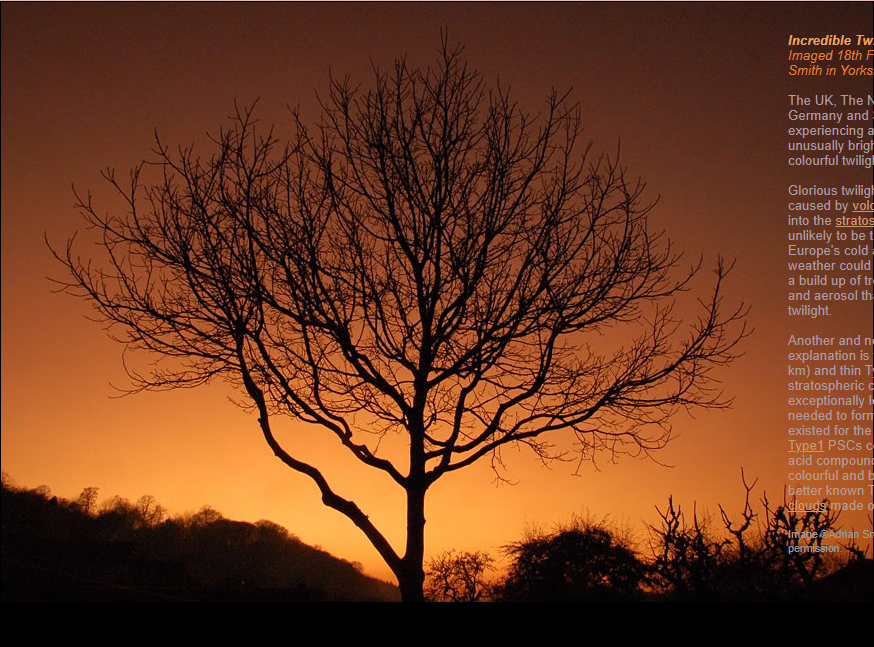Today's Feature Incredible Twilights
Today's Feature: Incredible Twilights
Twilights are a fascinating atmospheric phenomenon that captivates observers with their breathtaking colors and ethereal beauty. Recently, the UK, The Netherlands, Germany, and Scandinavia have been treated to a series of exceptionally bright and intensely colorful twilights that have left people in awe. These extraordinary displays have sparked curiosity and led experts to explore the reasons behind this mesmerizing occurrence.
Traditionally, glorious twilights have been associated with volcanic dust ejected into the stratosphere. However, in the case of these recent phenomena, volcanic activity seems unlikely to be the cause. Instead, scientists have turned their attention to other potential factors that could contribute to these remarkable twilights.
One possible explanation is the cold anticyclonic weather pattern that has been prevalent across Europe. This weather system may have resulted in a buildup of tropospheric haze and aerosol, which could enhance the intensity and vibrancy of the twilights. The interplay between the cold air masses and atmospheric particles can create a unique visual spectacle that captures the imagination.
Another intriguing hypothesis centers around the presence of high-altitude clouds known as polar stratospheric clouds (PSCs). These clouds form at altitudes ranging from 15 to 25 kilometers and are characterized by their thin and delicate appearance. The exceptionally low temperatures required for the formation of PSCs have been recorded in the region over the past day or so, making this explanation increasingly plausible.
It is important to note that there are different types of PSCs, each with its own distinct characteristics. The current hypothesis suggests that Type 1 PSCs, composed of nitric acid compounds, may be responsible for the incredible twilights observed in Europe. These clouds tend to be less colorful and bright compared to their Type 2 counterparts, which are composed of ice crystals and are commonly known as nacreous clouds.
To gain a deeper understanding of these fascinating atmospheric optics phenomena, Adrian Smith captured a stunning image of the incredible twilight on February 18th in Yorkshire, England. The image showcases the vivid colors and the awe-inspiring beauty of the phenomenon, providing a visual testament to the captivating nature of these events.
As researchers continue to investigate the factors contributing to these incredible twilights, it is evident that there is still much to learn about the complexities of our atmosphere. The interplay between weather patterns, atmospheric particles, and high-altitude clouds creates a dynamic and ever-changing canvas that paints the sky with awe-inspiring hues.
In conclusion, the recent series of extraordinary twilights in Europe has sparked curiosity and captivated observers with their intense colors and ethereal beauty. While volcanic activity seems unlikely to be the cause, experts are exploring alternative explanations such as tropospheric haze and aerosol buildup or the presence of Type 1 polar stratospheric clouds. These remarkable events serve as a reminder of the wonders that can be found within our atmosphere, and the ongoing research into atmospheric optics continues to unravel the mysteries of our ever-changing skies.

Incredible Twilights
Imaged 18th February by Adrian Smith in Yorkshire, England
The UK, The Netherlands, Germany and Scandinavia are experiencing a series of unusually bright and intensely colourful twilights.
Glorious twilights are sometimes caused by volcanic dust ejected into the stratosphere but this is unlikely to be the reason. Europe's cold anticyclonic weather could also have caused a build up of tropospheric haze and aerosol that enhanced the twilight.
Another and now more likely explanation is very high (15-25 km) and thin Type1 polar stratospheric clouds, PSCs. The exceptionally low temperatures needed to form them have existed for the last day or so. Type1 PSCs composed of nitric acid compounds are less colourful and bright than the better known Type2 or nacreous clouds made of ice crystals.
Image ©Adrian Smith, shown with permission.
Note: this article has been automatically converted from the old site and may not appear as intended. You can find the original article here.
Reference Atmospheric Optics
If you use any of the definitions, information, or data presented on Atmospheric Optics, please copy the link or reference below to properly credit us as the reference source. Thank you!
-
<a href="https://atoptics.co.uk/blog/todays-feature-incredible-twilights-3/">Today's Feature Incredible Twilights</a>
-
"Today's Feature Incredible Twilights". Atmospheric Optics. Accessed on November 26, 2024. https://atoptics.co.uk/blog/todays-feature-incredible-twilights-3/.
-
"Today's Feature Incredible Twilights". Atmospheric Optics, https://atoptics.co.uk/blog/todays-feature-incredible-twilights-3/. Accessed 26 November, 2024
-
Today's Feature Incredible Twilights. Atmospheric Optics. Retrieved from https://atoptics.co.uk/blog/todays-feature-incredible-twilights-3/.